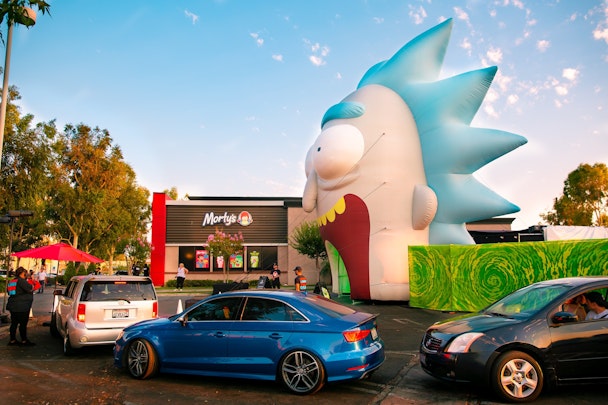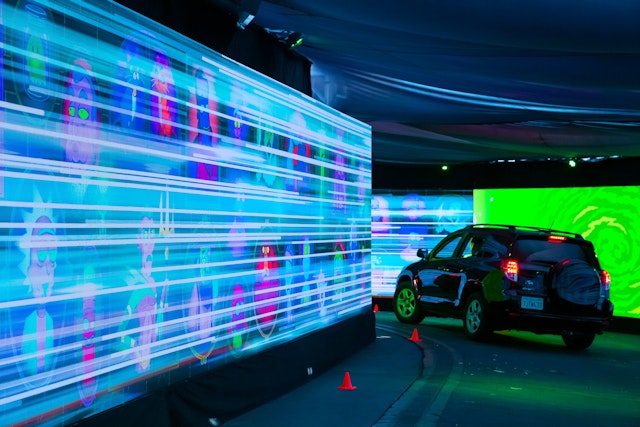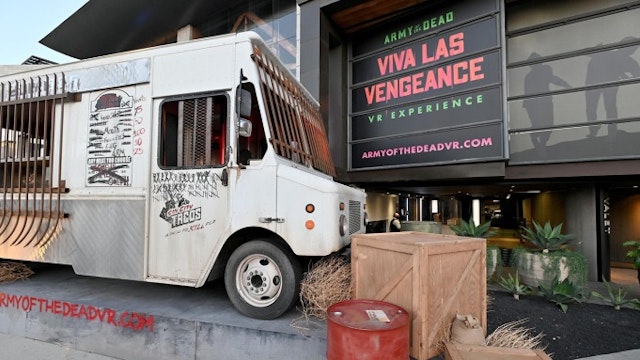Summer of pop-ups points to a promising future for marketers’ favorite medium
As the world reopened after the worst of the pandemic passed, brands took tentative steps to re-engage with consumers away from screens through the ever popular pop-up format. From Lego and TikTok to Netflix, L’Oreal and Toyota, we explore the summer of pop-ups as part of The Drum’s Experiential Marketing Deep Dive.

Rik and Morty’s Wendy’s takeover
The popularity of the pop-up format hasn’t waned in almost 10 years. Back in 2014, The Drum explored how marketers were beginning to buying vacant retail space in the same way they would buy media with a publisher.
Lisa Gramling, senior vice-president of research innovations and intelligence at Momentum Worldwide, a global experiential advertising agency, says the reasons for its popularity post-Covid are the exact same as pre-pandemic.
“Firstly, it’s low commitment. They give brands the ability to introduce themselves to a new market or consumer, test out new products and marketing tactics or, perhaps, look to re-establish themselves,” she says.
“Secondly, it offers you real-time research. Pop-ups allow a brand to capture feedback along with assessing pros and cons before making that often frightening ’final’ decision. They could be seen as large-scale ethnographies, observing consumers in the moment, watching initial reactions. Finally, if done right they also make for great social media content. By providing an amazing experience, the consumer will reward you with Instagram posts, tags, hashtags and, most importantly, sharing the content with their followers.”
One of the most popular pop-ups over the summer was a Wendy’s partnership with Adult Swim’s hit show Rick and Morty’s. It saw one of its restaurants in LA renamed Morty’s and introduced a themed menu with limited edition products as well as a complete transformation of the drive through with LED lighting.

It’s not the first time Wendy’s has experimented with the pop-up format, particularly around the ‘drive thru’ experience. It has done a ‘Ski Thru’ with ESPN and X Games in Aspen, a ’Sail Thru’ on the water at a college football game and a ‘Scare Thru’ extension at Halloween.
“The ability to interact on a one-on-one basis with the consumer is phenomenal,” says Jimmy Bennett, vice-president of marketing at Wendy’s, explaining why pop-ups have become a key channel in the restaurant chain’s marketing arsenal.
“Then there is that ability to create content that can connect back with consumers across the country. This is something fans, wherever they are, love to see – other fans experiencing it. That connection and association is hard to replicate in other ways. It’s a phenomenal tool and difficult to replicate in other ways. So we continue to come back to it. It’s really creative and we can have fun and it truly does incorporate fans.”
Fans reportedly queued seven hours to experience Morty’s. But Bennett says that’s not the only KPI it was looking at. While most marketers investing in pop-ups are only looking at the number of visits it might clock up, Bennett wanted this single LA restaurant to get the attention of Rick and Morty fans across America.
“I don’t have local KPIs, they’re national. If we treat pop-ups as local, the KPIs would be very different. The fact we’re able to nationalize is where the KPIs pay off,” he says, explaining that the content and social marketing plan, as well as rolling out some of the limited editorial products such as custom Coke flavors to all restaurants, means it’s capturing a wider audience.
“We’re really looking at talkability as the purest form of ROI. We look at other KPIs but that talkability and people wanting to associate with it is the true measure of whether it has been successful.
“There’s a really hungry fanbase out there that steps up to the plate. The fans are out there and they want more stuff. It’s not like a brand is being disruptive and getting in the way. It’s an extension of the fandom and something everyone is really excited to participate in.”
Grace Charge is head of brand experience and partnerships at Westfield, the shopping center chain. It has played host to an increasing number of pop-ups these past few years.
“One particular benefit for marketers pre-Covid was that pop-ups provided a way they could try something different in their arsenal without having to commit to the costs and logistics of running a permanent space,” Charge says.
According to a report it published earlier this year, as many as 91% of retailers are changing the use of their store space to introduce experiences, showing the value that brands are seeing in this particular format.
“The pandemic has definitely influenced how brands approach pop-ups, with many coming to appreciate the flexibility that pop-ups offer in regard to size, timings, interaction and more. In the first few months following the reopening of retail, brands were naturally focused on how they could bring pop-ups to life while adhering to government social distancing and Covid-19 guidelines.
“While we continue to work with brands on the traditional format of a ‘demonstration’ or retail pop-up, recently we’ve seen a lot more brands such as Netflix, MeeCBD and Tier willing to be bold in their vision of a pop-up and commit to creating an engaging and unique offering for visitors.”

One of its most engaging pop-ups has been the newly-launched Viva Las Vengeance: Army of the Dead VR experience in collaboration with Netflix. The immersive experience transports fans of the blockbuster film Army of the Dead into the heart of zombie-infested Las Vegas and was created in partnership with Fever and Pure Imagination Studios. The experience combines state-of-the-art VR with fan-favorite elements of the film.
Earlier this year it also partnered with TikTok to create the social media platform’s first ever UK pop-up. The ’TikTok House’ was an immersive two-story pop-up world that brought to life trends born from the platform, from sports and beauty to food and entertainment, with a range of content creation sessions hosted by creators such as Poppy O’Toole, Ehiz Ufuah, Jeremy Lynch and Ben Black.
Charge says all 130 session for the duration of the pop-up were fully booked for both the creator workshops and private recording sessions. Social engagement for the activation was extremely high, with over 11 million customers engaging with the Westfield branded content on the creator platforms.
Momentum Worldwide is seeing more clients confident in the format post-pandemic and points to the trend of AR and biometric technology being incorporated into the pop-up experience.
Gramling says: ”While this is something that we’ve been anticipating for a while now, it wasn’t expected to start being incorporated for years – it was assumed it would make a guest appearance here and there. Covid changed all of that. Trends that were predicted to emerge 10 years from now have been fast-tracked simply because technology has been working overtime since March 2020, along with demand from consumers.
”We are going to see more personalized interactions at pop-ups that will allow consumers to immerse themselves in the brand and take part in an envy-inducing experience all while feeling safe. Don’t get me wrong, physical interactions are and will be a component of the pop-up, however the how-to guide on that is currently being rewritten…”

